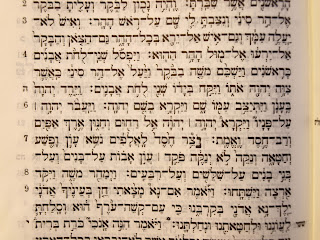Lukiessani heprean kielioppia törmäsin hauskaan kielikuvaan Jumalasta. Raamatun kerrontahan on hyvin suurelta osalta symbolista kieltä. Koska suuri ja käsittämätön Jumala ei mahdu ihmisen mielikuvitukseen, eikä ihminen ymmärrä taivaan kieltä, Jumalan on täytynyt ilmoittaa itsensä ihmiskielellä. Tämä kielikuva liittyy Jumalan pitkämielisyyteen.
When I was reading Hebrew grammar I found an interesting symbol of God. The Bible has been written with many symbols indeed. Because God is great and incomprehensible for us and people don't understand heavenly language, God had to manifest himself with human symbols. This symbol is dealing with God's patience/longsuffering character.
When I was reading Hebrew grammar I found an interesting symbol of God. The Bible has been written with many symbols indeed. Because God is great and incomprehensible for us and people don't understand heavenly language, God had to manifest himself with human symbols. This symbol is dealing with God's patience/longsuffering character.
Kun Mooses nousi toistamiseen Siinain vuorelle saamaan uudet laintaulut Jumalalta, sanotaan: "Ja Herra kulki hänen (Mooses) ohitsensa ja huusi: Herra, Herra on laupias ja armahtavainen Jumala, pitkämielinen ja suuri armossa ja uskollisuudessa" (2. Moos. 34: 6).
When Moses climbed up on the Mt. Sinai again for the new tables of commandments, we can read:
"The LORD passed by before him (Moses), and proclaimed, “The LORD! the LORD, a merciful and gracious God, slow to anger, and abundant in loving kindness and truth" (Ex. 34: 6).
When Moses climbed up on the Mt. Sinai again for the new tables of commandments, we can read:
"The LORD passed by before him (Moses), and proclaimed, “The LORD! the LORD, a merciful and gracious God, slow to anger, and abundant in loving kindness and truth" (Ex. 34: 6).
Salomo kirjoitti pitkämielisyydestä näin: "Pitkämielisellä on paljon taitoa, mutta pikavihaisen osa on hulluus" (Sanal. 14: 29).
Solomon wrote of patient like this: "He who is slow to anger has great understanding, but he who has a quick temper displays folly" (Prov. 14: 29).
Kummastakin edellä olevasta tekstistä löytyy heprean kielessä tämä sanapari: "PITKÄ NENÄ"
In the both Hebrew texts above we can find these two words: "LONG NOSE".
In the both Hebrew texts above we can find these two words: "LONG NOSE".
Matti Liljeqvistin sanakirjasta löytyy adjektiivi "erek".
In the wordbook of Matti Liljeqvist we can find an adjective "erek".
Sieltä löytyy myös substantiivi "appajim", mutta vain henkilönimenä. Appaim on nimetty mitä ilmeisimmin huomiota herättävän nenänsä mukaan (1. Aik. 2: 30, 31).
There is also a noun "appajim" but only as a name. Most apparently Appaim got his name after his special nose (1. Cron. 2: 30, 31).
Pienestä taskusanakirjasta löytyy nimisana "af", jonka duaalimuoto on "appajim".
In a small bocket-wordbook we can find the noun "af" and it's form in Dual "appajim".
In a small bocket-wordbook we can find the noun "af" and it's form in Dual "appajim".
Ja tässä kuva kieliopin sivusta, josta koko juttu lähti alkuun. Jumalan pitkä nenä kuvaa siis hänen pitkämielisyyttään/armollisuuttaan/laupeuttaan/kärsivällisyyttään. Jumalan nenää ei pidä sekoittaa Pinokkion nenään tai mihinkään muuhunkaan taiteen tai teatterin nenäsymboliikkaan yms., sillä Jumalan kielikuvat pitää avata Jumalan omilla sanoilla.
And then a picture of the grammar-book, where this story has it's start. God's long nose is a symbol of his longsuffering/merciful/gracious/patient character. We must not mix God's nose with Pinochio's nose or with any nose-symbols of art or theater etc., for we must use God's own keys to his images.
Jumala on Henki, joka hallitsee koko universuminsa. Siinä työssä tarvitaan kyllä tehokasta "nenää", että voi tietää yhtä aikaa kaiken kaikkialta. Jumala on sietänyt todella pitkään katsella synnin maailman mieletöntä menoa! Mutta varsin mielenkiintoista on huomata, että Jumalalla ei ole kolmea nenää, niin kuin kolminaisuuskuvissa esitetään.
God is a Spirit dwelling all the universe. He truely needs a very effective "nose" to get information from every corner of his universum. God has been gazing for a really long time at our stupendous living on this earth! But it's quite interesting for me to notice that God doesn't have three noses as we have seen many times in the pictures of the Trinity.

"Appajim" on "af"-sanan duaalimuoto, joka merkitsee "kaksi nenää" (huom. kaksi sierainta yhdessä nenässä). Jälleen kerran mieleeni tulee Paavalin loistava teksti (jota ei ole ehditty ainakaan vielä sekoittaa): "Jumala oli Kristuksessa, ja sovitti maailman itsensä kanssa" (2. Kor. 5: 19).
"Appajim" is a Dual form of the word "af" meaning "two noses" (note: two nostrils in one nose). Once again I can remember Paul's splendid words (not manipulated... not yet): " namely, that God was in Messiah reconciling the world to himself, not reckoning to them their trespasses, and having committed to us the word of reconciliation" (2. Cor. 5: 19).







Kauko Allén facebookissa:
VastaaPoistaHyväntuulinen ja ihan uuden uutukainen tieto ja näkemys Jumalasta. Kiitos Helinä.
Helinä Jokinen:
Symbolit ovat mielenkiintoisia!